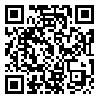BibTeX | RIS | EndNote | Medlars | ProCite | Reference Manager | RefWorks
Send citation to:
URL: http://journal.rums.ac.ir/article-1-22-en.html
Evaluation of ELISA Method Using the Excreted / Secreted Antigens of Toxoplasma for Toxoplasmosis Serodiagnosis in Rat
SH. Abdollahi PhD1*, A.Mahmoudzadeh PhD2, M. Bahadoran MSc 3
1 Assistant Professor, Dept. of Microbiology, Faculty of Medicine, Rafsanjan University of Medical Sciences, Rafsanjan, Iran
2- Associated Professor, Dept. of Micribiology, Faculty of Medic ine, Baghiatallah University, Tehran, Iran
3- Academic Member, Dept of Microbiology, Faculty of Medicine, Rafsanjan University of Medical Sciences, Rafsanjan, Iran
Background: Many studies have reported that Toxoplasma gondii excreted/secreted antigens (E/SA) appear to be a suitable marker for toxoplasmosis serodiagnosis. Most of those studies have used E/SA obtained from supernatent of toxoplasma cell culture, or by incubating tachyzoites in cell free media (RPMI- 1640). The present study, evaluated the ELISA method, using the components of peritoneal fluid of infected mice (as another source of E/SA), for toxoplasmosis diagnosis in rat.
Materials and Methods: Peritoneal fluids of infected mice by interaperitoneal inoculation (IP) with toxoplasma tachyzoits were collected after 3 days of infection and centrifuged at 750×g for 15 min, then the supernatant was precipitated with ammonium solphate soulution (30% saturated)
Forty noninfected (male) rats (7-10 weeks old) were injected with 4 × 106 toxoplasma tachyzoits IP and their serum samples were collected at 8, 15, 22 and 60 days after the infection. Then 10 samples from each day were tested by Dye- test. The sera of 15 and 60 days after infection of all animals were selected as suitable samples. Then the sera of these days were tested by the dye-test and ELISA using E/SA.
Results: The cut-off point of ELISA with 99% confidence was found to be 0.33 and optical density (OD) of all the sera samples of 15 and 60 days after infection and 2 negative sera were over than test cut-off. Moreover, sensitivity and specificity of the method were determined to be 100% and 95%, respectively.
Conclusion: Our findings showed that ELISA in the condition of using ammonium sulphate precipitation has a good enough sensitivity and specificity for toxoplasmosis diagnosis in rat.
Key words: Toxoplasmosis, Excreted/Secreted Antigens, ELISA, Toxoplasma Gondii
*Corresponding author Tel: (0391) 5234003, Fax:(0391)5225209, E-mail:habdollahi38@yahoo.com
Journal of Rafsanjan University of Medical Sciences and Health Services, 2004, 3(4):232-242
| Rights and permissions | |
 |
This work is licensed under a Creative Commons Attribution-NonCommercial 4.0 International License. |






